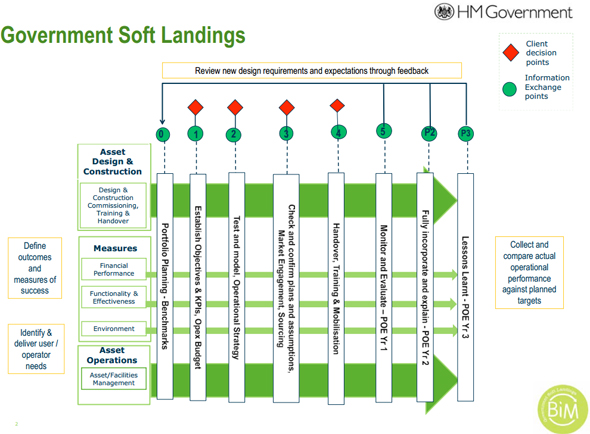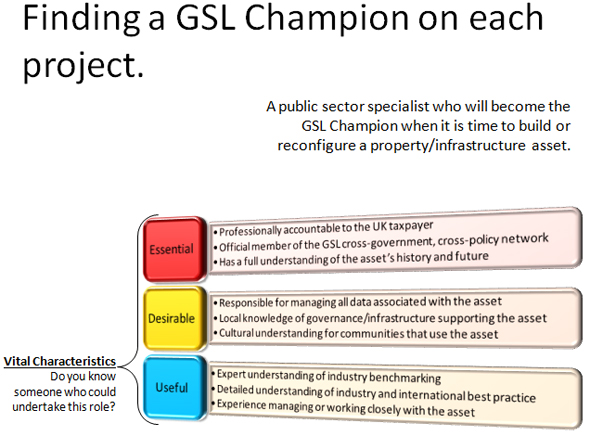Government Soft Landings (GSL) : The term "soft landing" already exists in some parts of the construction industry and to a lot of people only reflects the need for a smooth transition from the design and construction phase to the operational phase of a built asset.
Good idea, but we need more than that in a government construction industry that is aimed at meeting public needs using taxpayer's money. Ultimately that is who GSL is about, us the public. It's part of the jigsaw of providing cost-effective services that meet public need.
Buying a car
If we buy a car we know what we want from it. Almost sub-consciously we choose it for its functionality and effectiveness, is it big enough, is it safe, is it easy to use, is it reliable; we choose it because the capital cost and predicted running costs fit our pocket; we choose it because the carbon dioxide emissions and level of environmental impact satisfy our environmental conscience and most of all we buy it because of what it means to our business needs and our social needs and the lifestyle outcomes that they both bring.
As the end user we are given a simple guide on how to operate the car, how to adjust seat position to give a safe driving position, how to set the comfortable temperature and how to dim the lights. We also get a metering strategy that provides us with a measure of fuel consumed, hours of use, distance travelled and often much more. What's more we get a sophisticated car management system that tells us when cooling water becomes to hot, when lubricant levels are too low and many other early warnings of breakdown. We even have instructions on how to clean the car and look after it on a day-to-day basis.
The people who provide our car maintenance service are given a geometric model of the car with a full digital record of the technical data on each material, component, assembly and system. They can identify and replace any paint finish, bolt and brake disc simply by referring to the data. What's more they can understand the intended operation of the engine management systems. So they have a complete digital asset register with a computer aided car management system that tells them how to carry out all maintenance activities.
When we have bought the car and operated it for a while we conduct performance tests on what we have bought, is it durable, is it reliable, does it carry my double bass, are the maintenance costs what I expected, does it deliver the level of fuel consumption that I expected? We complain if it doesn't meet those criteria and maybe some fine-tuning can be done to improve fuel consumption or someone explains that our driving in racing style does not align with the recognized test criteria.
When we tell the manufacturers about our complaints they take it on board and either take corrective action by re-calling the vehicle for modification or make sure that future models overcome the problem so that their sales figures do not dip.
Buying, construction and refurbishment of a built asset
If that's what we get when we buy a car why wouldn't we want that when we buy a building, a rail system, a motorway or a flood alleviation scheme?
Government Soft Landings is about getting that same level of service and an information focus has to help to achieve the following:
Service level required by the client
- Targets – running cost, capital cost, environment and functionality
- Comparison of predicted performance against targets
- Simple operating instructions
- Early warnings of problems
- Metered data on the performance
- Ready access to all digital data about our asset
- Cost effective transfer of data from construction to operation
- Service provider having all required operational data
- Actual measured performance of our asset
- Fine tuning the actual performance
- Recorded performance
- Feedback to the design and construction team.

As a construction client you may just expect all of the above but there is a difference between the car industry and the construction industry. Over many years of traditional practice the construction clients have not always demanded this common sense approach. It is especially important as we construct increasingly complex assets.
When we buy a car it has already been designed, built in great numbers and tested in operation. Car-makers rely on standardization of parts. The car industry has a network of distributors that acts as a feedback path for the comments of car owners to reach the manufacturer. In the car industry the car manufacturer has extensive input from the end-users and maintenance providers. For each new model the manufacturer sets new targets to meet customer needs and they know that they have to check for compliance with those targets at each stage of development.
Many construction industry projects are a once only requirement and to date, unlike cars, they do not draw extensively on standardization of design, parts and construction methods. At the time of issuing a completion certificate most forms of contract expect a fully completed asset with engineering systems that have been fully tested and set to work. The construction team is expected to leave when the practical completion certificate is issued. The asset performance is not tested and the only feedback comes through user complaints often legally supported.
Shouldn't we expect a fully functioning asset at handover? Yes we should and we must focus on obtaining effective setting to work of engineering systems and their control systems at the point of handover. But that is not enough because most modern assets need at least a year of exposure to our different climate conditions, to different levels of use and to different users before their performance is fully tested.
So to get the construction assets we want we must identify required outcomes, define performance targets, demand all required operating data, require fine-tuning and test actual performance.
A lot of projects do not generally employ structured feedback from end-users and operators so unlike the car industry, we have to do more to bridge that gap in the construction industry. To overcome this lack of structured lessons learned and to deal with the one-off project, someone on the client team must champion a focus on delivering the required outcomes. There are many pressures that can drive the design and construction team to focus upon project outputs (such as meeting programme, reducing procurement cost) and lose focus on the client's required outcomes.
Government Soft Landings Champion
As a modern client we must demand a focus on the processes of design, procurement, construction method, commissioning and handover to ensure that the supply chain are constantly reminded of the need to strive to deliver the required outcomes and meet the stated performance targets. This can be driven by client questions delivered by a Government Soft Landings Champion. Someone who represents the financial, environmental and social outcomes required.

A modern client should seek also to have input from the asset operation provider to give an operability review at all stages of the project development through and on behalf of the client. We should expect their input at the same time as the design and construction in order to identify operating strategy, operating plan, operating costs and to prepare for the first day of operation. Where an operational provider is not already appointed this focus on how to operate the asset should wherever possible lead to early tendering and appointment of an operations provider. This approach can also be driven by client questions delivered by a Government Soft Landings Champion appointed to represent the client.
If a procurement system does not recognise the importance of end-user and operator input then we might question how effective it will be at delivering the required outcomes. Also where it is known that operator expertise could be limited we might consider the need to improve that level of expertise and even more than usual we might focus the design, construction and commissioning upon delivering an asset that is simple to understand and easy to operate.
Adopting this approach with the construction team is not an additional cost prior to handover. The client is simply asking the questions they should be asking anyway and the construction team is answering the questions they should be answering anyway.
Involving the construction team in aftercare, fine-tuning and performance evaluation might cost a fraction of the total cost of the asset and can be tendered in competition. Construction teams with vision for the future already see this as an opportunity for them to differentiate their service, to deal with small problems before they become big problems and to learn about the consequences of their decisions.
The GSL Champion is not a new role; it is simply about asking the right questions of the construction team and the operation team.
The GSL Champion will come from the government client organisation, however a project manager from the private sector can deliver the day-to-day role.
Involving the operations team requires thought about either modifying existing contracts or about early appointment of a new contract.
The business case
Proving the business case for Government Soft Landings is difficult because it is usually successful and delivers against performance targets. We have to experience a Government "Hard" Landing where targets have not been met before we might recognise that GSL is a common sense, effective approach to prevent mis-alignment of anticipated and actual outcomes.
We are nonetheless looking for well-reasoned case studies to indicate assessed savings obtained through all the components of the GSL approach.
If you feel that you can contribute, please contact info@bimtaskgroup.org.
More information
Construction industry assets are not cars, but we would do well to consider and enhance the manufacturing industry approach so that we can get the assets we require to meet public need using taxpayer's money.
If you wish to read further information please go to www.bimtaskgroup.org and look at the content under the pull down menu entitled GSL. You will find information about GSL Policy, a short Summary, a standard Presentation and Guidance Documents which are all currently being tested with government departments.
Download the Government Soft Landings Enabled By BIM presentation (.pdf, 5.5Mb) ![]()
Related reading
What does the term soft landings mean?
Soft landings help ensure a smooth ride for all concerned as buildings move from construction to occupation and use. Here we explore how to ensure operational efficiencies across the project timeline by means of a soft landing strategy with a passing nod to Government Soft Landings.

